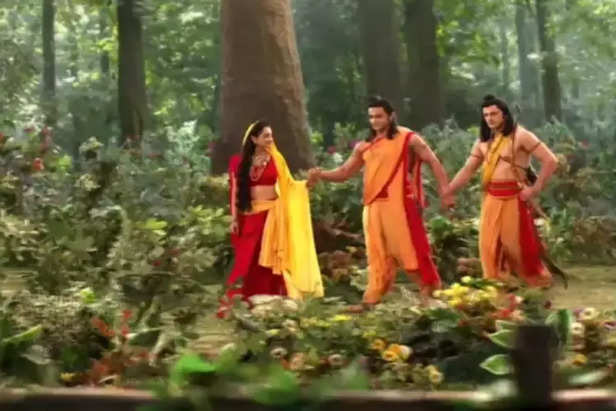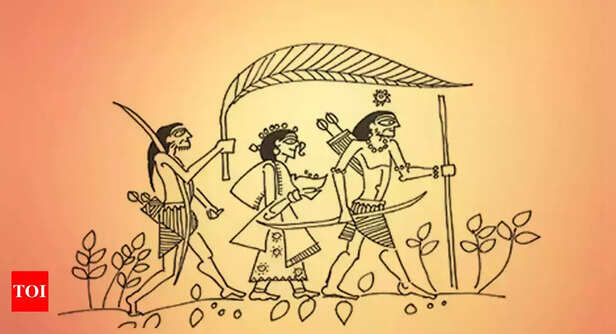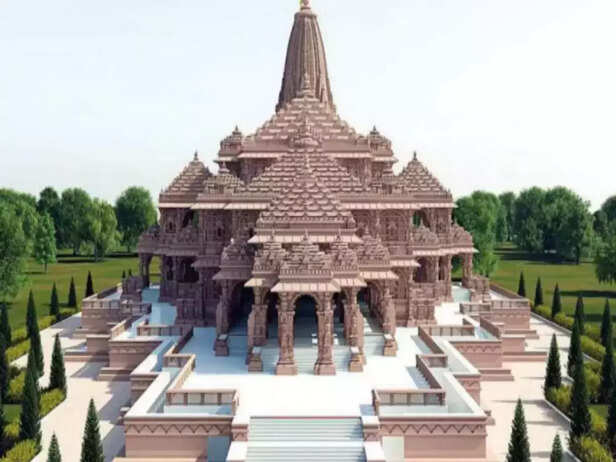You Won’t Believe Why Rama Didn’t Kill Ravana in the Jain Ramayana!
Nidhi | Jan 20, 2025, 00:53 IST
( Image credit : Timeslife )
Uncover the shocking truth behind why Lord Rama didn't kill Ravana in the Jain Ramayana. This alternative version of the Ramayana presents a radical twist, showcasing Rama's mercy instead of vengeance. Explore the deeper spiritual message and profound lessons found in Jain mythology.
Not Rama, but Lakshmana kills Ravana. This unexpected twist challenges everything you thought you knew about the timeless epic. In the Jain Ramayana, the battlefield is not just a place of war but a stage for profound moral dilemmas. Here, the hero’s victory isn’t marked by the clash of swords but by the silence of restraint. Imagine an epic where non-violence (ahimsa) isn’t just a principle but the cornerstone of heroism. Welcome to the Jain Ramayana—a tale reimagined through the lens of compassion and karmic justice.
 In this retelling, Rama, also known as Padma, isn’t a divine incarnation but a mortal king whose strength lies in his unshakable commitment to virtue. When he finally confronts Ravana, the mighty demon king, Rama faces not an enemy but his own conscience. As he looks at Ravana, he utters, “What glory is there in victory stained with blood?” His words ripple through the battlefield, echoing the Jain principle:
In this retelling, Rama, also known as Padma, isn’t a divine incarnation but a mortal king whose strength lies in his unshakable commitment to virtue. When he finally confronts Ravana, the mighty demon king, Rama faces not an enemy but his own conscience. As he looks at Ravana, he utters, “What glory is there in victory stained with blood?” His words ripple through the battlefield, echoing the Jain principle:
"True strength lies not in vanquishing others but in conquering one’s own anger and desires."
It is Lakshmana, the steadfast Vasudeva, who steps forward. Unlike the fiery younger brother we know, Jain texts depict Lakshmana as the agent of karma, destined to bear the weight of Ravana’s downfall. Rama’s hands remain unsullied, his commitment to non-violence intact, while Lakshmana fulfills the karmic duty that the universe demands.
Ravana in the Jain Ramayana isn’t a caricature of evil but a tragic figure caught in the web of his own karma. A learned king, skilled in arts and sciences, he is ultimately undone by his unchecked desires. His downfall isn’t just a punishment but a resolution of the karmic balance.
In a moment of introspection, Ravana gazes at the battlefield and reflects:
"The weight of karma spares no throne, no king. Even gold crumbles beneath its burden."
His death at Lakshmana’s hands is neither celebrated nor mourned. It is simply the culmination of choices—his and others—in the intricate weave of karma.

Sita’s journey in the Jain Ramayana radiates spiritual strength. Abducted by Ravana, she remains unbroken, her virtue an impenetrable shield. While Ravana is captivated by her beauty, he soon realizes her purity is beyond his reach.
In awe, he confesses, “Her soul shines brighter than any jewel in my palace.” This portrayal emphasizes the Jain ideal of inner strength and detachment, where Sita becomes a beacon of resilience rather than a victim of circumstance.

In this version, Lakshmana steps out of Rama’s shadow to play the pivotal role of Ravana’s slayer. As the Vasudeva, he carries the burden of action. But his act of killing isn’t driven by rage or vengeance—it is a duty, one he accepts with a heavy heart.
Before striking the final blow, Lakshmana pauses and reflects:
"To lift a weapon is to lift the weight of karma; may my actions restore balance, not chaos."
His victory isn’t heralded with grand celebrations but is acknowledged as a somber necessity. In the Jain Ramayana, the act of slaying Ravana is not glorified but viewed as a step toward restoring harmony.

The Jain Ramayana doesn’t just retell an epic; it transforms it into a spiritual journey, embodying the following principles:

Unlike the grandeur of Rama’s return to Ayodhya in the Hindu Ramayana, this version concludes on a deeply spiritual note. After Ravana’s death, Rama and Lakshmana renounce their kingdoms, choosing the path of enlightenment (moksha).
As they leave behind their royal duties, Rama says:
"The treasures of this world fade like shadows; the only true victory lies within."
This ending elevates the tale from a story of conquest to one of self-realization, offering a profound reflection on the transient nature of power and the enduring quest for inner peace.
The Jain Ramayana offers timeless wisdom that resonates even in today’s world:
 The Jain Ramayana reimagines a beloved epic, replacing the clamor of war with the silence of introspection. It challenges us to look beyond conventional notions of heroism, focusing instead on the battles within. This version isn’t just a story of gods and kings; it’s a guide for navigating the complexities of life with integrity and compassion.
The Jain Ramayana reimagines a beloved epic, replacing the clamor of war with the silence of introspection. It challenges us to look beyond conventional notions of heroism, focusing instead on the battles within. This version isn’t just a story of gods and kings; it’s a guide for navigating the complexities of life with integrity and compassion.
As one verse beautifully encapsulates:
"In the silence of restraint lies the roar of true courage."
Through its unique lens, the Jain Ramayana transforms an ancient tale into a timeless beacon of wisdom, offering lessons that continue to illuminate the path to peace and purpose.
A Non-Violent Hero: Rama’s Dilemma

Lord Rama
( Image credit : Timeslife )
"True strength lies not in vanquishing others but in conquering one’s own anger and desires."
It is Lakshmana, the steadfast Vasudeva, who steps forward. Unlike the fiery younger brother we know, Jain texts depict Lakshmana as the agent of karma, destined to bear the weight of Ravana’s downfall. Rama’s hands remain unsullied, his commitment to non-violence intact, while Lakshmana fulfills the karmic duty that the universe demands.
Ravana: A Villain of Complexity
In a moment of introspection, Ravana gazes at the battlefield and reflects:
"The weight of karma spares no throne, no king. Even gold crumbles beneath its burden."
His death at Lakshmana’s hands is neither celebrated nor mourned. It is simply the culmination of choices—his and others—in the intricate weave of karma.
Sita’s Abduction: A Different Shade of Strength

Sita-Rama
( Image credit : Timeslife )
Sita’s journey in the Jain Ramayana radiates spiritual strength. Abducted by Ravana, she remains unbroken, her virtue an impenetrable shield. While Ravana is captivated by her beauty, he soon realizes her purity is beyond his reach.
In awe, he confesses, “Her soul shines brighter than any jewel in my palace.” This portrayal emphasizes the Jain ideal of inner strength and detachment, where Sita becomes a beacon of resilience rather than a victim of circumstance.
Lakshmana: The Karma Bearer

Retracing Sita and Ramas Journey
( Image credit : Timeslife )
In this version, Lakshmana steps out of Rama’s shadow to play the pivotal role of Ravana’s slayer. As the Vasudeva, he carries the burden of action. But his act of killing isn’t driven by rage or vengeance—it is a duty, one he accepts with a heavy heart.
Before striking the final blow, Lakshmana pauses and reflects:
"To lift a weapon is to lift the weight of karma; may my actions restore balance, not chaos."
His victory isn’t heralded with grand celebrations but is acknowledged as a somber necessity. In the Jain Ramayana, the act of slaying Ravana is not glorified but viewed as a step toward restoring harmony.
Jain Values Woven into the Epic

Ramayana
( Image credit : Timeslife )
The Jain Ramayana doesn’t just retell an epic; it transforms it into a spiritual journey, embodying the following principles:
- Ahimsa (Non-Violence): Rama’s refusal to harm Ravana underscores the power of peace and restraint, even in the face of great adversity.
- Karma: The narrative intricately ties every character’s fate to their past actions, highlighting the inescapable law of cause and effect.
- Detachment: The characters, particularly Sita and Rama, exemplify the importance of letting go of worldly attachments to attain spiritual clarity.
The Ending: From Thrones to Liberation

Ayodhya: Ram Mandir
( Image credit : Timeslife )
Unlike the grandeur of Rama’s return to Ayodhya in the Hindu Ramayana, this version concludes on a deeply spiritual note. After Ravana’s death, Rama and Lakshmana renounce their kingdoms, choosing the path of enlightenment (moksha).
As they leave behind their royal duties, Rama says:
"The treasures of this world fade like shadows; the only true victory lies within."
This ending elevates the tale from a story of conquest to one of self-realization, offering a profound reflection on the transient nature of power and the enduring quest for inner peace.
Lessons from the Jain Ramayana
- Non-Violence as Strength: Rama’s adherence to peace teaches us that true courage lies in restraint and compassion, not aggression.
- Karma Shapes Destiny: The emphasis on karmic justice serves as a reminder to live with mindfulness and accountability.
- The Pursuit of Inner Fulfillment: The renunciation by key characters inspires us to seek purpose beyond material gains.
A Tale for Every Era

Ramanand Sagar: Ramayana
( Image credit : Timeslife )
As one verse beautifully encapsulates:
"In the silence of restraint lies the roar of true courage."
Through its unique lens, the Jain Ramayana transforms an ancient tale into a timeless beacon of wisdom, offering lessons that continue to illuminate the path to peace and purpose.
